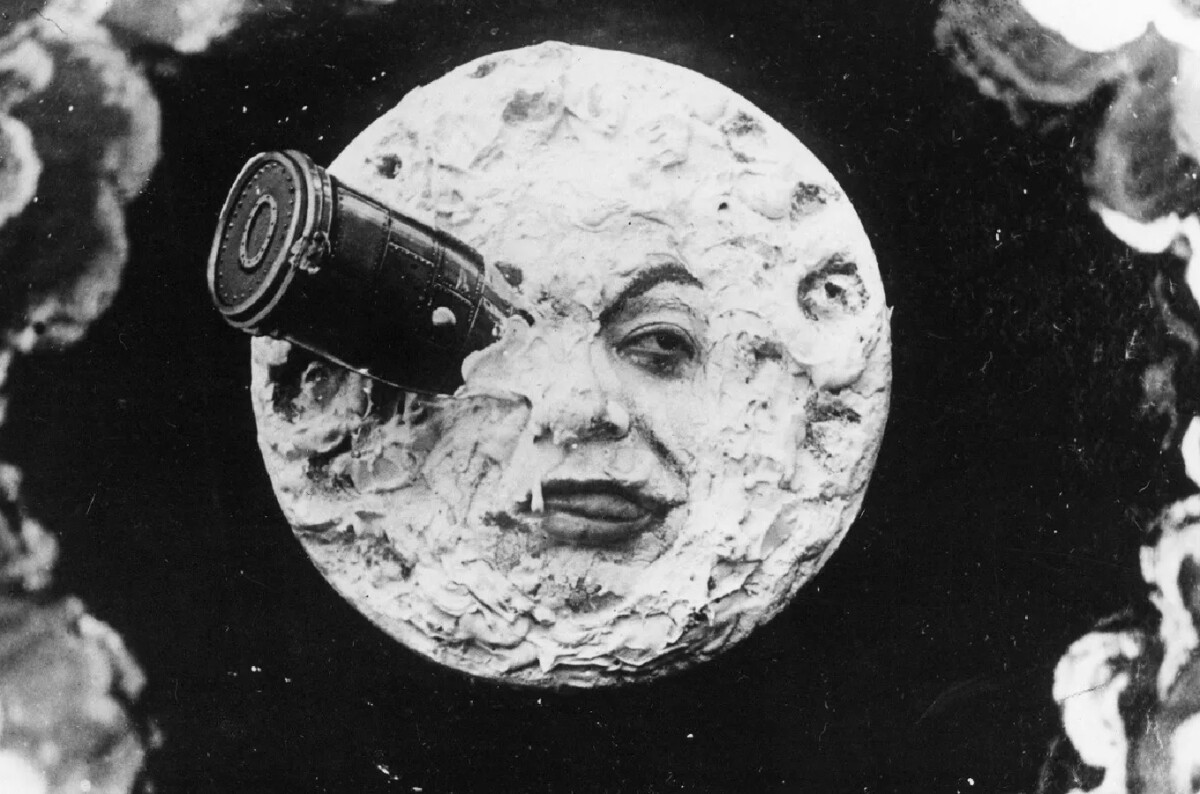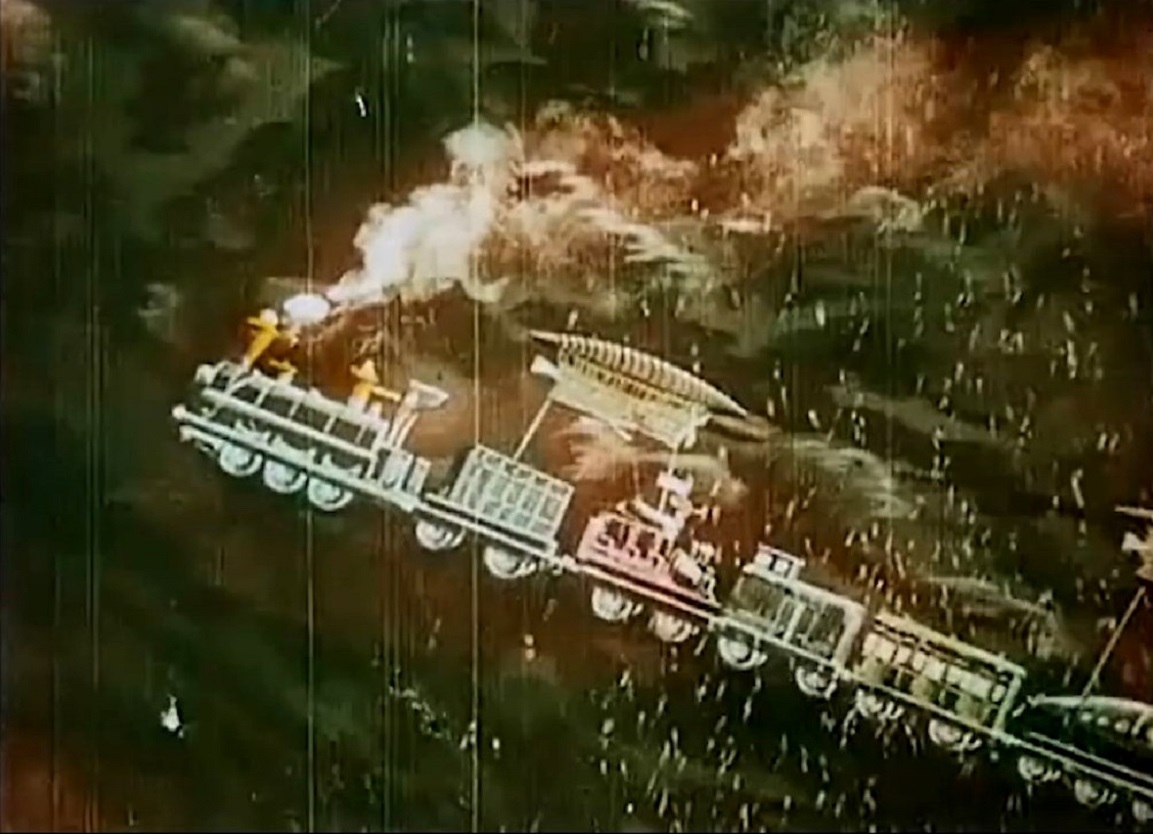Melies Cinemagician is a special screening of a selection of films from Georges Melies presented by Vancouver’s Vancity Theater to celebrate the 150th anniversary of his birth. The show was a live performance involving a score composed especially for the event, displays of conjuring tricks and a magic lantern show. The same year also saw several other homages to Georges Melies in Martin Scorsese’s Hugo (2011) and the documentary The Extraordinary Voyage (2011) made to accompany a digital colour restoration of Melies’s seminal film A Trip to the Moon (1902).
Georges Melies was one of the founding fathers of cinema. Born in Montreuil in 1861, he became a stage magician, eventually purchasing the theatre owned by the great 19th Century conjuror Jean-Eugene Robert-Houdin. He was among one of the audience present when the Lumiere Brothers premiered the world’s first ever movie in 1895. Melies immediately saw the potential and tried to buy one of the cameras but was refused. He eventually obtained a projector from England and converted it into a camera. His first few films were similar to the Lumieres – no more than the presentation of ordinary, everyday scenes on the screen. Melies happened upon the notion of special effects by accident one day when his camera jammed while he was filming a funeral procession. Played back, a coach appeared to turn into a hearse and Melies immediately began to experiment with this and other effects. He became the father of the modern special effects film and patented many of the methods in use today.
Melies made some 500-800 films during his career, which lasted up until 1913 – most of these only between 1-3 minutes long, although some of his later films are up to 20 minutes. He also built the world’s first film studio in his garden in Montreuil. The finished films would screen at the Robert-Houdin Theatre, there being no such things as movie theatres in the day. He was forced out of business in the 1913 due to piracy of his films by Thomas Edison in the US and the arrival of World War I where his film stock was melted down to provide boot heels for the French army. Only around 200 of Melies’s films survive today.
The evening opens with the most famous film that Melies is known for, A Trip to the Moon (1902), which is often erroneously claimed to be the world’s first science-fiction film. Melies borrowed freely from Jules Verne’s From the Earth to the Moon (1865) and H.G. Wells’s just published The First Men in the Moon (1901). Where Verne and Wells made journeys to the Moon that were scientifically extrapolated from what was known at the time, Melies makes no such effort – he uses Verne’s idea of a projectile fired from a giant cannon but the rest of the venture into space is pure fantasy – The Moon has a face (where the projectile impacts into its eye) and Melies’s astronauts are not scientists and engineers but more like Mediaeval magicians in pointy hats, robes and long beards. Indicative of the less than serious intent of the piece, the projectile is loaded into the cannon by a group of dancing girls and once on The Moon, the astronauts encounter Wellsian Selenites and engage in slapstick pratfalls before returning to Earth. As serious science, A Trip to the Moon is absurd; as science-fiction, it seems to belong more to the burlesque tradition than it does a voyage into the unknown, but it was one of the first and, at a time when cinema had not yet even learned to cut up shots and move the camera around, is a considerable imaginative leap. In terms of its own whimsy, it is undeniably charming. That said, I do think Melies’s more ambitious An Impossible Voyage is a far superior effort – see below.

Most of Georges Melies’s films were variations on the tricks he performed as a stage magician. A number of these shorts were screened throughout the program, demonstrating the various effects that Melies popularised in his films. The Man with the Rubber Head (1901) is a three-minute effort based around simple matte effects wherein a man connects a detached head to a set of bellows and uses these to inflate the head to giant size and then deflate it again, before it explodes in a puff of powder. The entire effect is based around the rewinding of the film footage so that the head (Melies’s own) can be exposed in a blacked out area using simple zoom in and out effects to give the appearance of it expanding and shrinking. Similar effects appear in The Dwarf and the Giant (1901) where Melies creates a double of himself then expands to the size of a giant, towering over the other self and sprinkling confetti down on his head.
The most famous technique that Melies discovered was the stop-action camera effect. This is evident in the one-minute long A Nightmare (1896) based around simple stop-action substitutions as a man sleeps in bed and various figures, including a woman, a clown, even the Moon with a face again, appear in and out of his dreams and dance around his bed. We also get to see the first of two versions that Georges Melies made of Cinderella (1899). Most of this version is based around simple stop-action substitutions to create appearances, disappearances and transformations – the Fairy Godmother appears out of the fireplace and then disappears (via a trapdoor that opens in the floor!); where Melies uses stop-action to transform cardboard mice into larger ones and then coachmen; and finally the pumpkin into the coach. After the ball, Cinderella returns home and is greeted by human-sized moving clocks (something I do not recall being in the fairytale), before the prince comes searching for her. Almost all of the other aspects of the fairytale have been stripped away to focus on the trick effects but Melies does a remarkable job of condensing the story to be told within six minutes. Melies later remade the story as the more ambitious 24-minute long Cinderella or the Glass Slipper (1912).
By the time of The Monster (1903), Melies’s stop-action effects had become highly sophisticated. The piece takes place in Egypt (in front of a painted backdrop of The Sphinx and Pyramids) where a sorcerer produces a skeleton that develops a life of its own, he hides it behind a sheet where it begins to dance, then expands in size, extends its neck and turns into a woman and back to a skeleton again. The level that Melies’s stop-action trickery was working at at this point is highly sophisticated and the episode is charmingly well choreographed. The same can be said of The Black Imp (1905) where a devil figure causes the bed, tables, chairs and bureau in a man’s bedroom to keep moving around, stacking up, multiplying and disappearing, leading him on a merry frustrated chase. Again, the level of trickery involved has become highly sophisticated and the episode appealing comic. The Infernal Cake-Walk (1903) is another enjoyably comic romp (given great brio by Wayne Stewart’s score) where we see various female dancers and a devil figure (which is capable of detaching its legs and arms) dancing in Hell.

Melies also discovered the double-exposure and this is evident in the film One-Man Band (1900) where a conductor (again played by Melies) creates seven copies of himself to sit in a row of chairs and play all the instruments of an orchestra. This is perhaps the one film where Melies’s background as a conjuror is most evident where we see him as though on a stage facing the (cinematic) audience and producing copies of himself, making them and himself vanish again, before reappearing to take a bow. Double exposure effects and orchestras also occur in the quite surreal The Melomaniac (1900) where Melies throws multiple copies of his head up alongside giant musical notes on the power lines overhead to act as the score for the female band he conducts below.
By the time of Gulliver’s Travels Among the Lilliputians and the Giants (1902), these double exposure and matte effects have become exceedingly well polished. This is perfect piece of artistry where Melies has stripped Jonathan Swift’s Gulliver’s Travels (1726) to only three scenes – the famous one with Gulliver waking up a prisoner of the Lilliputians pinned down on a beach (although this is a very different to the most portrayals of the scene where here the Lilliputians have built an entire house up around him) and then dining at a table where the Lilliputians ascend ladders to fill his cup; followed by a scene where he is a tiny figure in the kingdom of Brobdignag placed in the midst of the palace card table. The trick effects that allow the matching of the different elements of the scene are expertly done.
The final piece of the evening was Melies’s An Impossible Voyage (1904), which I have reviewed in more depth elsewhere. At 20 minutes, this was an epic among Melies’s usual productions of only a couple of minutes long. It was his much more ambitious successor to A Trip to the Moon and shows his balance of elaborate sets and costumes, models, double exposures and stop-action effects at the absolute peak of their art form.
Throughout the event, effort was made to replicate things in the style that Georges Melies presented his films. The show’s producer, local musician Wayne Stewart, performed a score that he had written for the occasion. The show was fronted and narrated by local stage magician Travis Bernhardt who delighted the audience by performing a number of prestidigitations throughout the evening, each to illustrate some point from the films we were about to see. The narration itself came with an impeccably well-researched bio of Melies, his background and methods. Melies apparently also accompanied his film screenings at the Theatre Robert-Houdin with live magic lantern shows and in like kind we received a wordless performance by Vancouver’s Mind of a Snail Puppet Company (consisting of Chloe Ziener and Jessica Gabriel) that mixed the use of a slide projector, colour transparencies, marker pens, cutout puppets and mime work with charming results.
(Screening at the Vancity Theater November 12-13, 2011)

